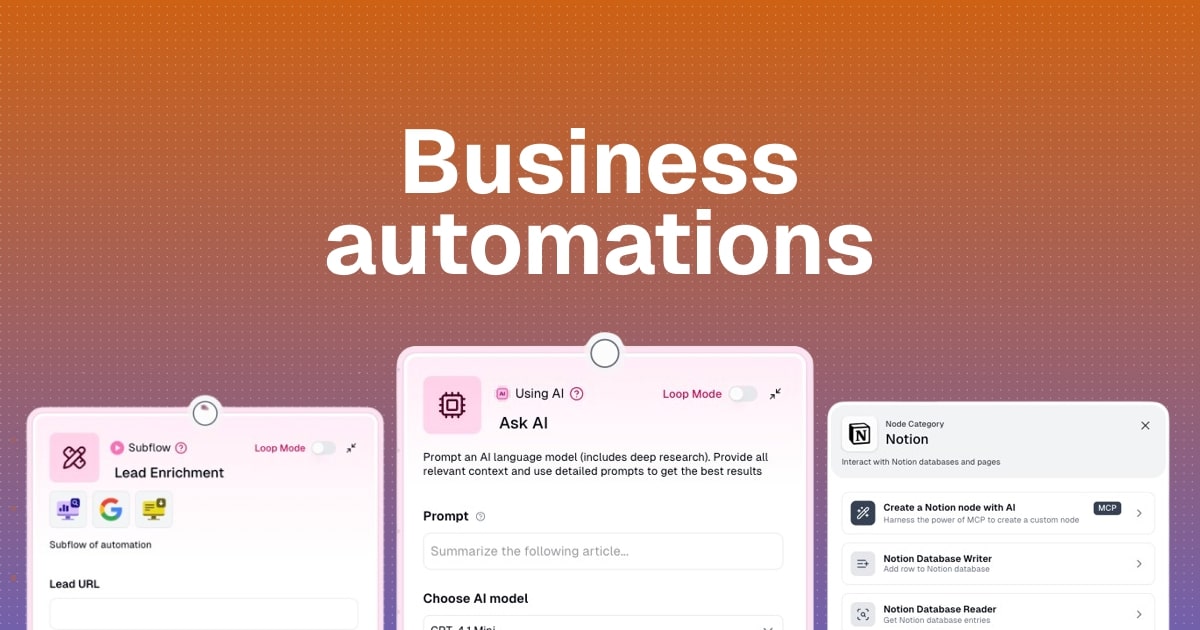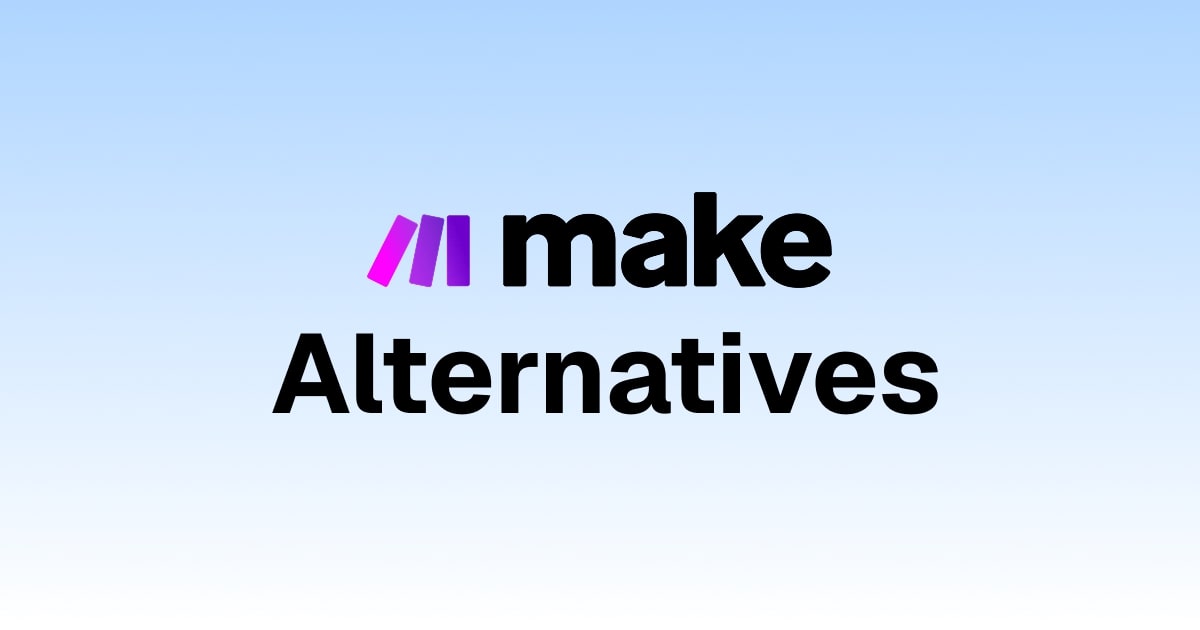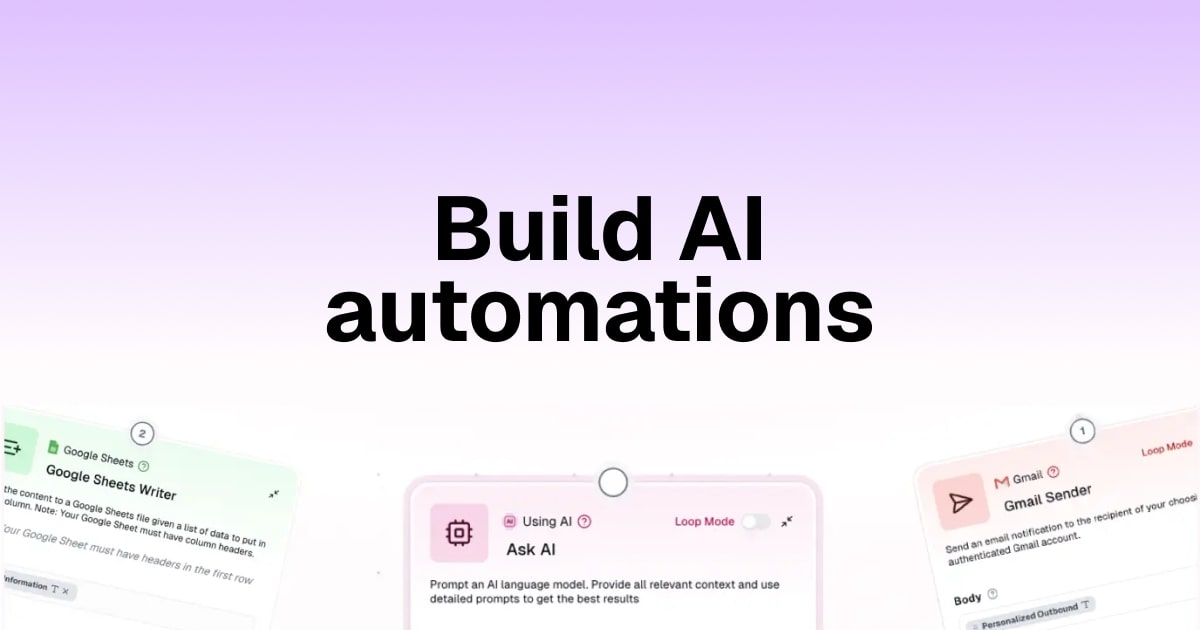9 Slack AI agent use cases (and how to build them)
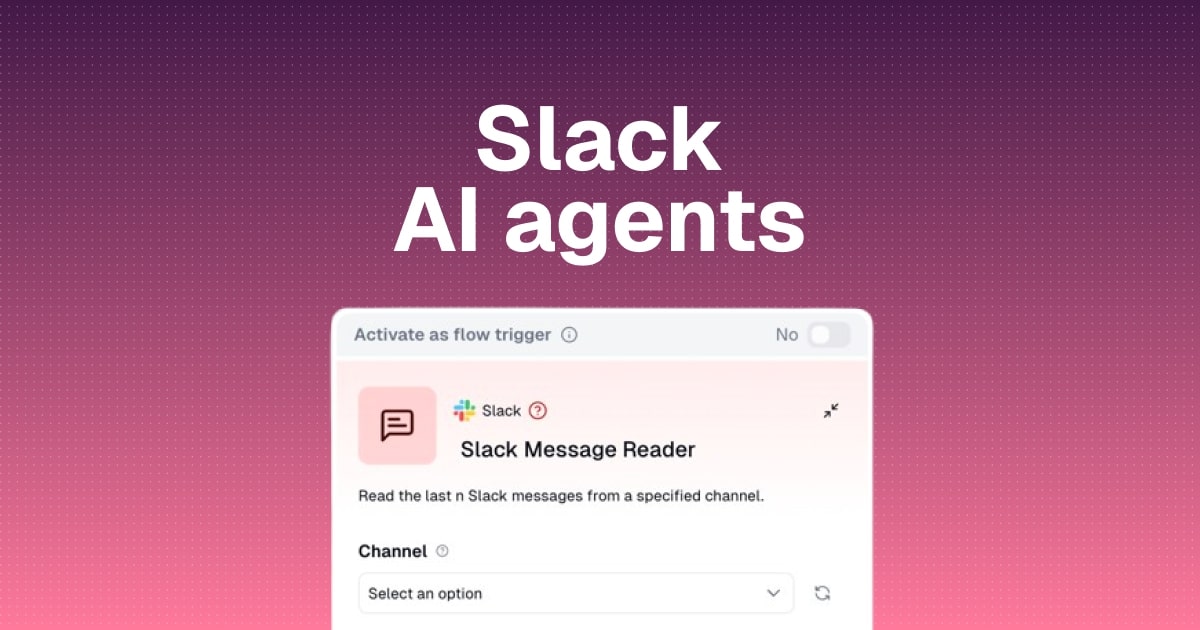
If you use Slack every day for work, this one's going to be juicy.
We all know automation is back, and now AI agents are all the craze. Which means Slack AI agents are finally having their moment.
Look, I was just as skeptical as everyone else in tech when AI claimed it would take over jobs and do work as well as a human could. But what I've come to realize is that AI is actually useful when it comes to doing IC-level tasks (caveat: with a lot of context behind them).
And because Slack has a built-in bot feature, this means you can create AI agents that act like IC-level employees right inside your Slack channels. I know there’s already a Slack Marketplace, but this goes way beyond that.
I'm talking about creating AI employees you can chat with to fetch data, make decisions, and take action on their own. A true embodiment of an AI agent vs an AI workflow.
So in this article, I'm breaking down nine Slack AI agent use cases you can actually build (without needing to hire a developer). Whether you're in sales, marketing, support, or ops, there's probably one here that will forever change the way you interact with your existing tech stack.
Let's get into it.
What is a Slack AI agent?
A Slack AI agent is a Slackbot that acts as an AI employee right inside of your Slack channels. These agents conveniently live inside of your Slack workspace and are set up for different tasks that can read data from your tech stack and make decisions on your behalf.
When you have these Slack AI agents set up, you can simply chat with them like a teammate and ask it for stuff (and tell it to do stuff).
What makes this new from anything I've seen before is that the agent can actually think and respond. It uses an LLM (like GPT, Llama, Grok, Claude, DeepSeek, or Gemini) as its brain, which means it can read context, make judgment calls, and give you answers or results in real time.
This makes it different from traditional automation tools that just move data from Point A to Point B. And it acts more like a teammate that can reason with what you need.
In this article, I’ll show you real Slack AI agents you can use across marketing, sales, and support. But these are just examples. You can build agents for pretty much any repetitive task or workflow where you need quick answers and smart actions without leaving Slack. And I’ll show you how to build them after we go over some use cases.
Here they are if you want to get a quick overview:
Otherwise, keep scrolling to go over each one in depth.
9 use cases for Slack AI agents in 2026
Here are the best Slack AI agents you can build:
- Content review agent
- Campaign performance agent
- Lead enrichment agent
- Sales rules Q&A agent
- Pre-call briefing agent
- Quote and proposal generation agent
- Support escalation agent
- Customer health alert agent
- Instant knowledge base agent
Okay, let’s go over exactly what each of these does.
1. Content review agent
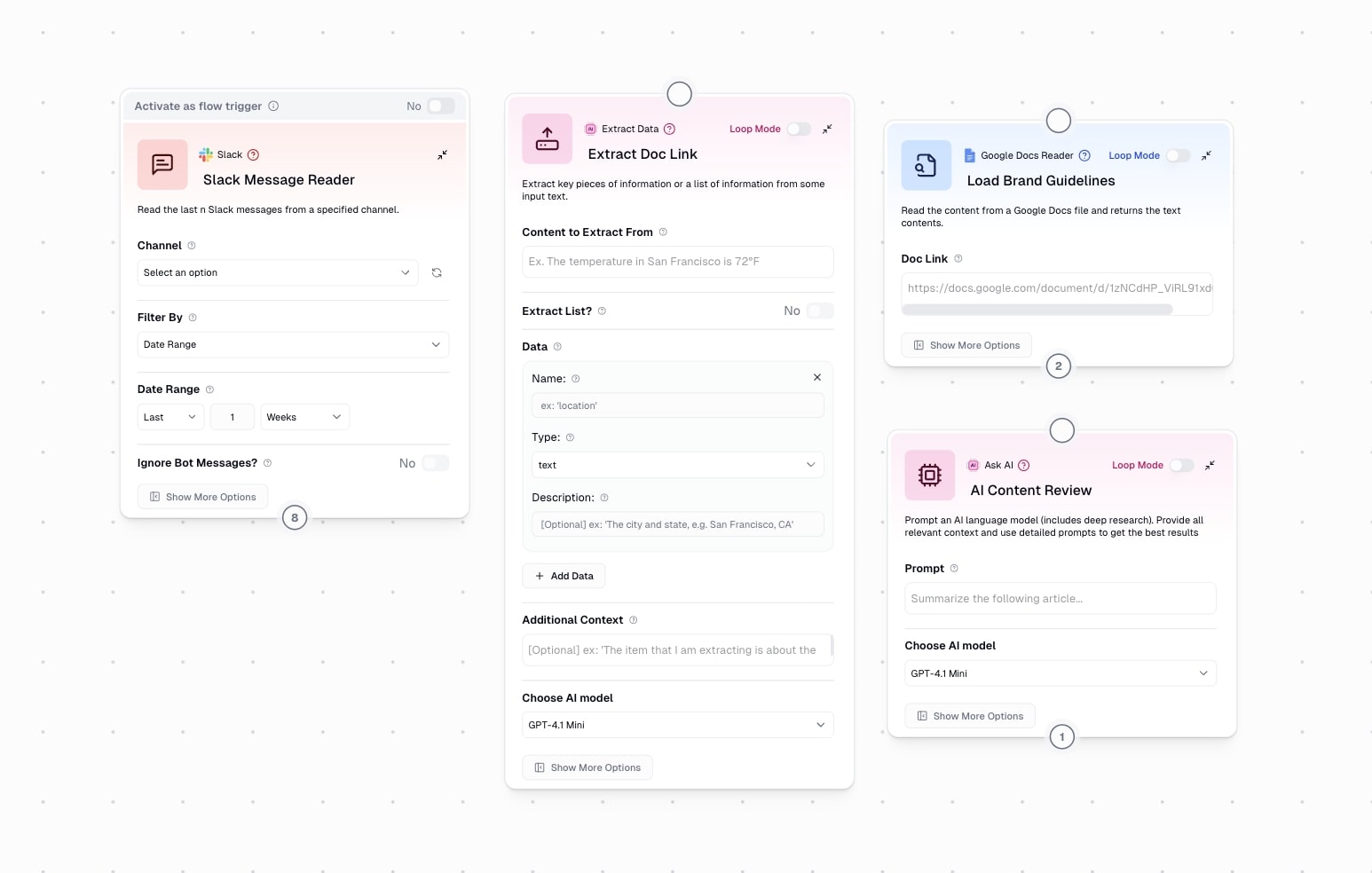
- Category: Marketing
- How it helps you: Speeds up content review and publishing by scanning drafts for brand alignment and grammar in seconds, then automating approval and distribution across your CMS and social channels.
Back when I was running the blog at Webflow, I had grown a pretty big freelance team. We consisted of editors, writers, content managers that published in the CMS, and me who focused mostly on strategy and direction.
One of the things that often became a bottleneck was that the freelance writers would output faster than our editor could review them. She had to review things for grammar and also how on-brand they were. This often took some time, and there were more drafts than she could handle when we scaled our freelance writing team.
So when I tried to hire another editor, I thought that things would speed up. But I found myself constantly having to train the new editor, and there was just something about the existing editor that I had that I couldn't find in anyone else.
With this content review agent, you can now create your own editor that can scan through all of your content and make sure it's on brand and clear in just a few seconds. In fact, this is one of my favorite use cases for AI in content marketing.
So let's say you're a content marketing team at a SaaS company and you post a new article. If you have a Slack channel called #content-marketing, you can paste your Google Doc draft in the channel and ask your content review agent to:
- Extract the content and check it against your brand guidelines
- Notify the content lead for approval
- Once approved, the agent can automatically publish it to your CMS, create social media posts to promote the article, and even schedule those posts
- It can notify your team when all tasks have been completed and are ready to go
I don't know about you, but this is quite powerful. You're essentially creating an AI assistant that can help you in your content workflow, based on content you already have.
I'm not saying to use AI to write your articles. But I am saying you can create this agent to act as your content operating system and help you manage an entire workflow.
And with the conversational interface of Slack, it feels like you're just chatting with a teammate. Which is what Albert did with managing quality assurance for content.
Okay, staying on the topic of marketing, let’s go to our next Slack AI agent integration.
2. Campaign performance agent
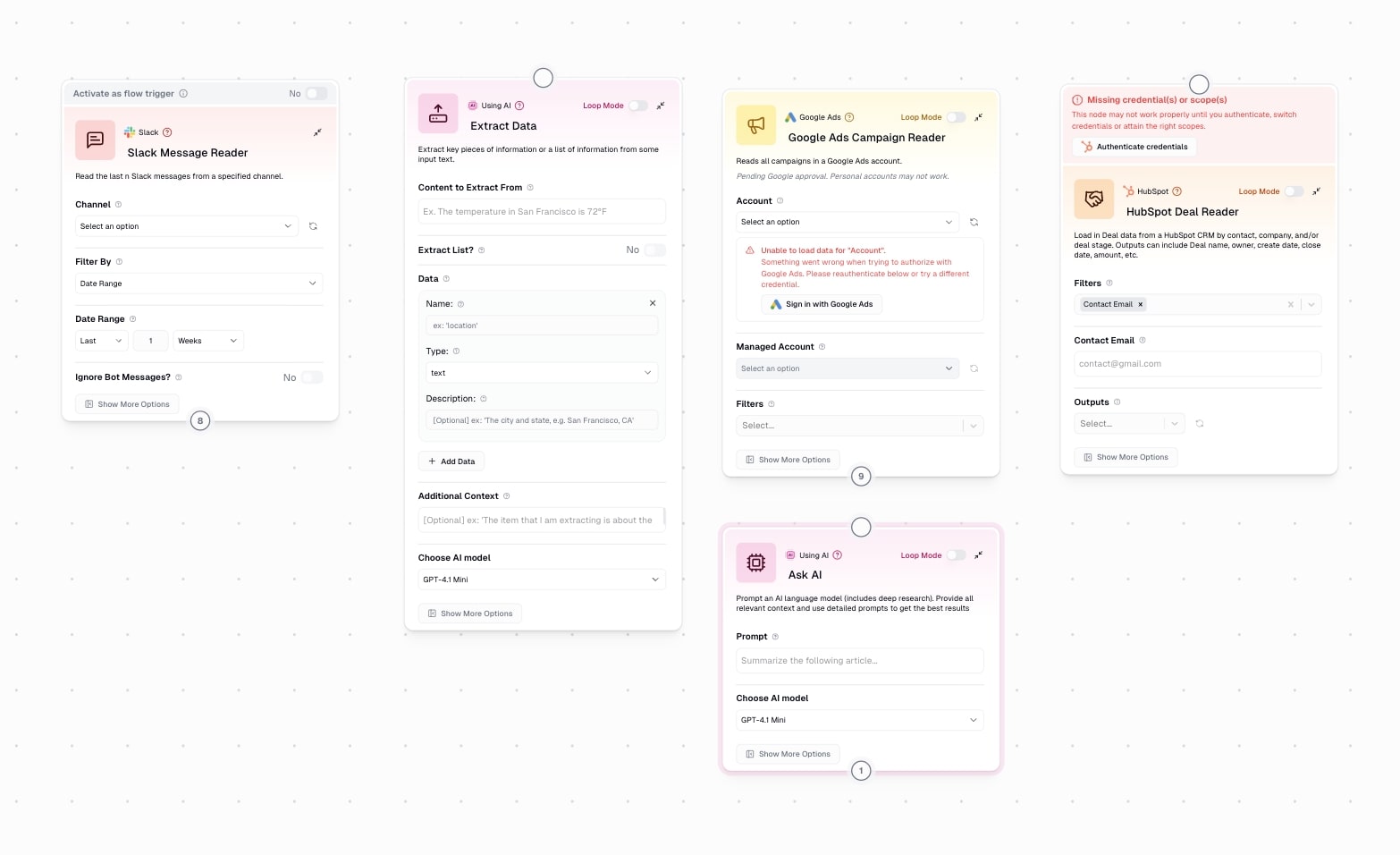
- Category: Marketing
- How it helps you: Automates weekly performance reporting by pulling data from all your ad platforms and CRMs, summarizing key metrics, and flagging underperforming campaigns with recommendations.
Marketing teams are often evaluated based on performance. You could be doing organic UGC content on Instagram, TikTok, and whatever short-form platform. You could be running Google ads or managing influencers on YouTube. Whatever the case may be, you need to make sure that there is a positive ROI.
This is where a campaign performance Slack AI agent comes into play. For example, every Monday morning at 9:00 AM, you can have your agent send an automated report in a Slack channel called #marketing-dashboard.
The funny thing is, one of the first tasks I was given at my first marketing job was going into Facebook ads and manually reporting on our numbers in a spreadsheet. So this use case hits close to home.
Here's what this agent can do:
- Pull data from Google Ads, Facebook Ads, HubSpot, or any other platform or CRM
- Summarize spend, leads generated, cost per lead, and top-performing creatives
- Flag campaigns that are underperforming by 20% or more with recommendations on what to do
The result here is that you can save multiple hours per week on manual reporting. And at the same time, once you have the Slack AI agent set up, you can talk to it at any time throughout the week.
Randomly remember a creative you were curious about? Just ask the Slack agent how it's performing. This takes chatbots to a whole new level. We've come a long way from Cleverbot.
All jokes aside, you can program this Slack agent to have context across all of your platforms and AI tools. Take your whole marketing stack, mash it into an AI agent, and give that AI agent access to Slack so you can talk with it.
Okay, let's go over one more use case for marketing.
3. Lead enrichment agent
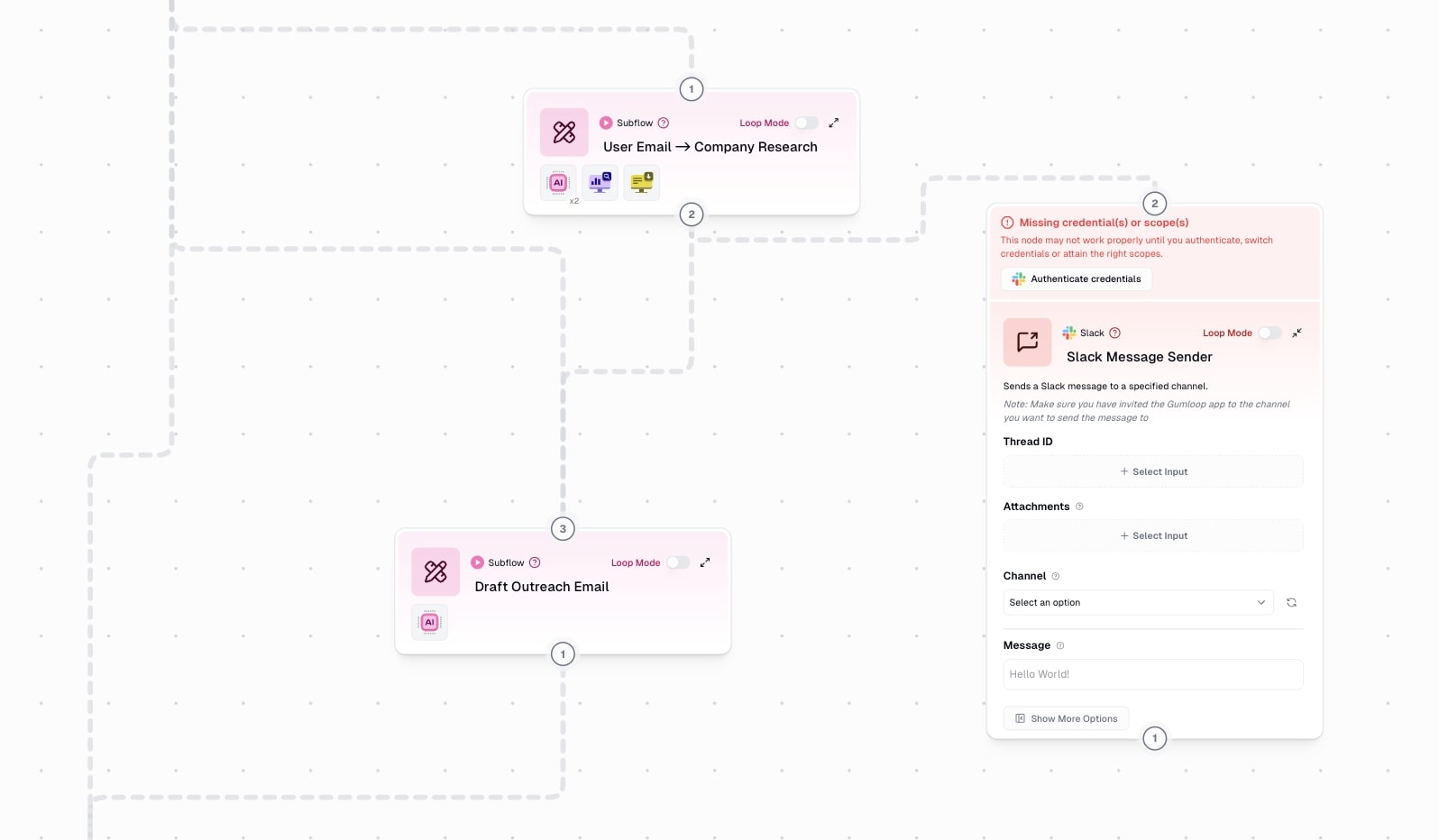
- Category: Marketing
- How it helps you: Automatically enriches incoming leads with company data, scores them against your ICP, and routes qualified prospects to your sales team with full context.
There are tons of tools out there like Apollo, Clay, and any new AI app designed for lead generation. But what if you could create an AI agent that can have the functionality of all of these tools right within Slack?
Sometimes you might have a website visitor fill out a form on your site to download something. But they may end up leaving with just their name and a work email. But how do you know if this is actually a qualified lead and it makes sense for your sales team to reach out to?
This is where a lead enrichment agent comes into play.
In this case, you may have a high-intent lead that is added to the CRM like Marketo or Salesforce. And with this agent, you can have it:
- Enrich lead data like pulling information about the company size, the website's tech stack, and any recent news about the company online
- Score the lead based on certain ICP criteria that you've set
- Post any new qualified leads to a Slack channel like #hot-leads with full context and assign it to an SDR
Look at that, an AI agent finally creating synergy between marketing and sales teams.
As a result, this agent can give you a huge percentage increase in demo booking rates from better-qualified handoffs.
And like the other agents we've gone over, you can chat back and forth with it to pull any more information about a particular lead or account. This is especially important if you're creating content and you're trying to evaluate which pieces brought in the most "hot leads." It completely changes the decision-making process and your marketing strategy.
Okay, this is a nice transition into using a Slack AI agent for sales operations.
4. Sales rules Q&A agent
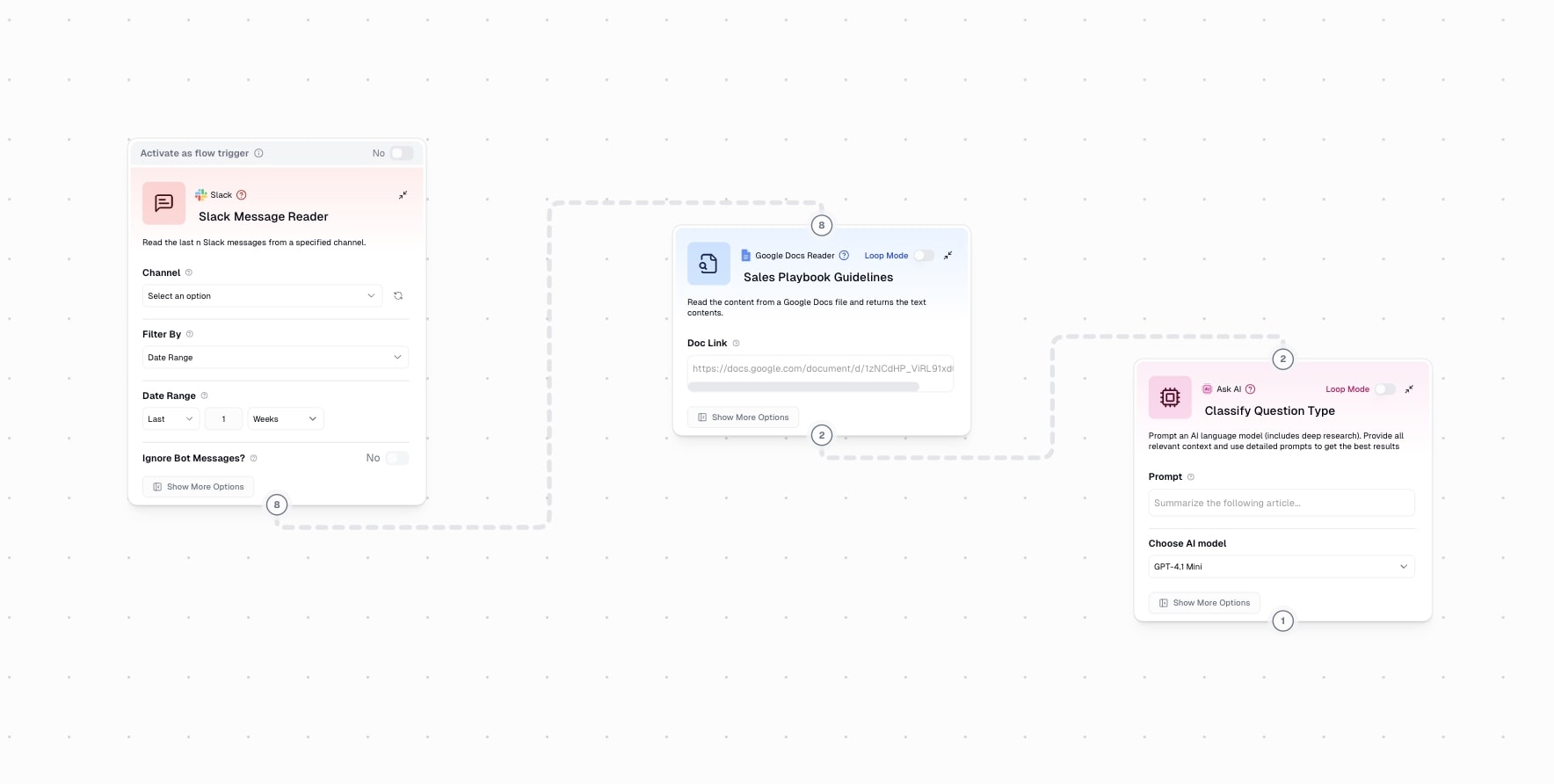
- Category: Sales
- How it helps you: Gives your sales team instant answers to pricing, discount approvals, and deal guidelines without waiting for leadership or digging through docs.
If you're on a sales team, creating an AI Slack agent is probably going to be the best thing you can do for yourself.
Say you’re in the middle of a call and the prospect asks about pricing flexibility. But you have no idea what the discount cap is for a deal their size. So you message your manager on Slack, wait around for a response, and by the time they get back to you the call is over and the momentum is dead.
This is where a sales rules Q&A AI agent comes to play.
For example, a sales rep can type in the #sales channel "What's our discount cap for deals under $50K?" The agent searches your sales playbooks, pricing guidelines, and discount approval docs, then comes back with an answer like, "Per Q4 pricing policy, 15% max discount without VP approval."
But you can also take this a step further and give the Slack AI agent more context. You can integrate this agent with Salesforce so when a rep asks about a specific account, the AI automatically pulls:
- Deal stage, amount, and close date
- Recent activities and notes
- Contract terms and past purchases
- Contextual recommendations based on deal size and history
So if a rep asks, "What's the latest on Acme Corp?" the agent might respond with, "Acme Corp is at $75K ARR. For upsells over $100K, you can offer a 15% discount with VP approval."
The sales rep gets instant answers without leaving Slack. You cut leadership questions in half and speed up deal cycles because everyone has what they need in real time.
And like the other agents we've covered, you can keep the conversation going. You can ask it follow-ups, request more data, or clarify something you're confused about. And often, that confusion can start before the conversation with a prospect happens. Which brings us nicely into the next sales use case.
5. Pre-call briefing agent
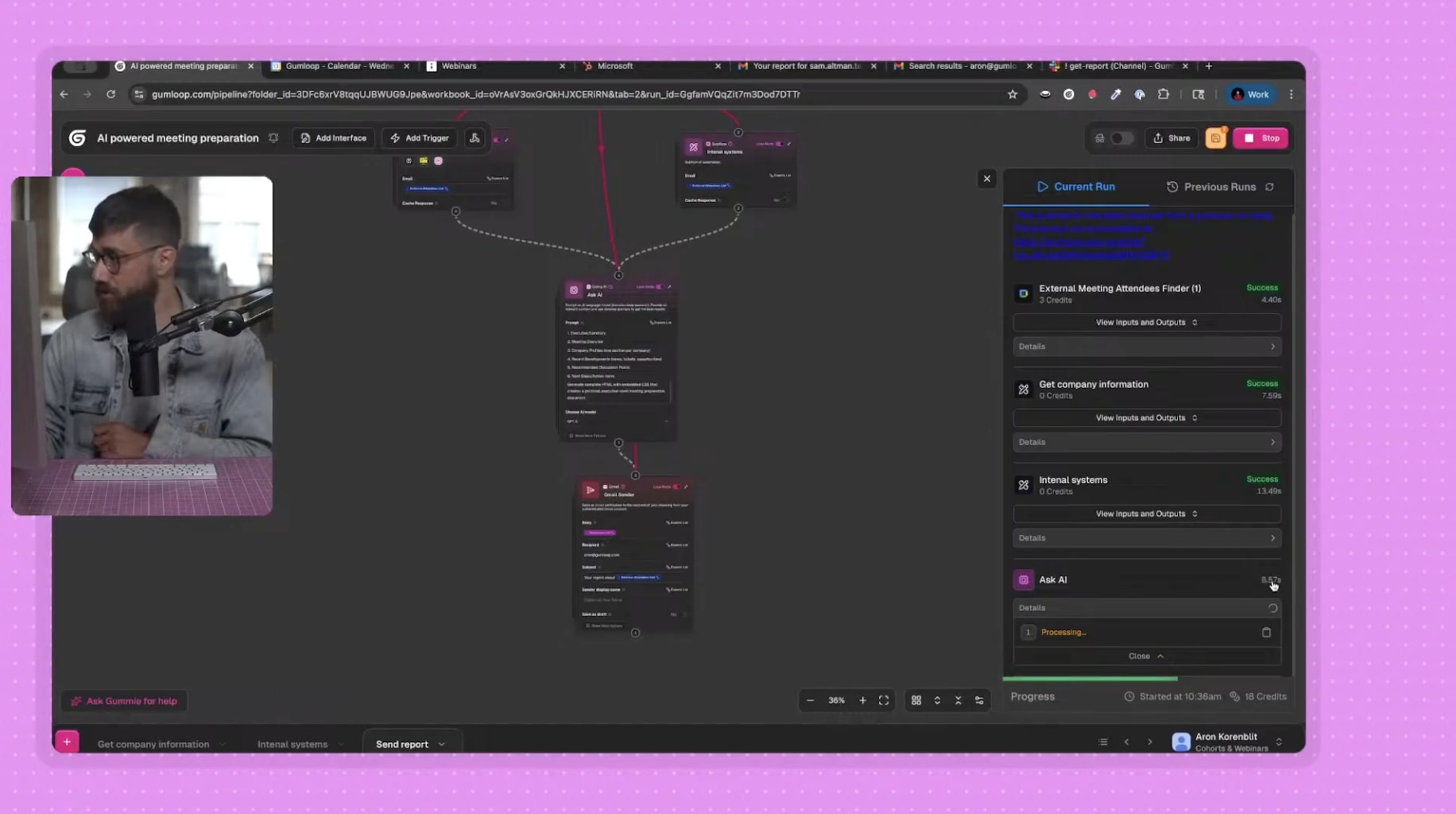
- Category: Sales
- How it helps you: Compiles all the context you need before a call in seconds, including recent company news, LinkedIn updates, past interactions, and similar won deals.
You have a demo call in 30 minutes. You know the company name, maybe a few bullet points from the initial email, but that's about it. So now you're scrambling to open five different tabs. LinkedIn profiles of the attendees, recent company news, past notes scattered on a notepad. Maybe a few case studies to reference.
By the time you piece it all together, you have three minutes to actually prepare for the conversation And you think to yourself, yolo.
This is where a pre-call briefing agent makes your life easier.
Before your call, you type “/prep-call Acme Corp” in Slack. The agent immediately compiles:
- Recent company news and press releases
- LinkedIn updates from the people you're meeting with
- Past interactions and notes from your CRM
- Pain points they've mentioned in previous conversations
- Similar won deals you can reference for credibility
It delivers a clean two-minute briefing straight to your DMs. Without needing to hunt down context, everything is prepped for you right before your call.
This way, you feel more confident going into discovery calls. And when you're better prepared, you’ll ask better questions, reference relevant examples, and show your project you have your stuff together (really wanted to use the other word but we’ll keep it family-friendly).
Some sales teams have seen close rates go up by 30% just from having better context before calls.
And if something comes up mid-call and you need more info, you can message the agent in real time.
6. Quote and proposal generation agent
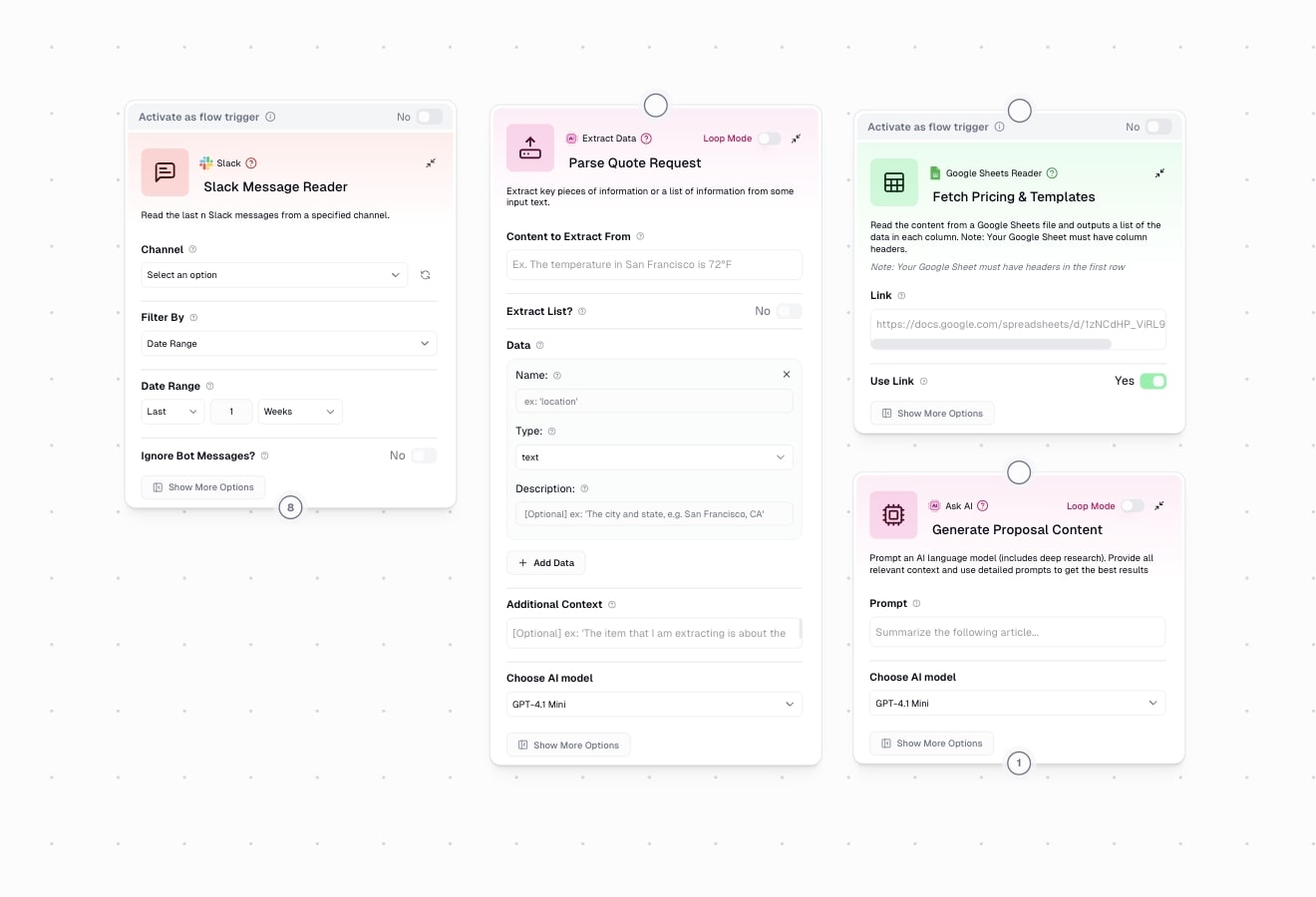
- Category: Sales
- How it helps you: Generates custom quotes and proposals in seconds, pulling pricing from approved templates and tracking when they're opened or signed.
After a good discovery call, the last thing you want is to spend the next day building a proposal from scratch.
But that's usually what happens, and it’s something I’ve personally done in the early days of my content marketing agency. You're copying and pasting pricing, looking for the right case studies, formatting everything in a doc, and hoping you don’t under or over explain anything.
With a quote and proposal generation agent, you skip all of that.
For example, after your call, you type something like “/create-quote Acme Corp - 50 seats, annual, add premium support” in Slack. The agent:
- Generates a custom proposal with pricing pulled from your approved templates
- Includes relevant case studies based on the prospect's industry
- Creates a DocuSign link and tracks when it gets opened or signed
- Posts an update to #sales-wins when the prospect signs
Quote turnaround goes from a day to less than 10 minutes. Your prospect gets what they need while the conversation is still fresh. And you move on to the next deal. Bada bing, bada boom.
7. Support escalation agent
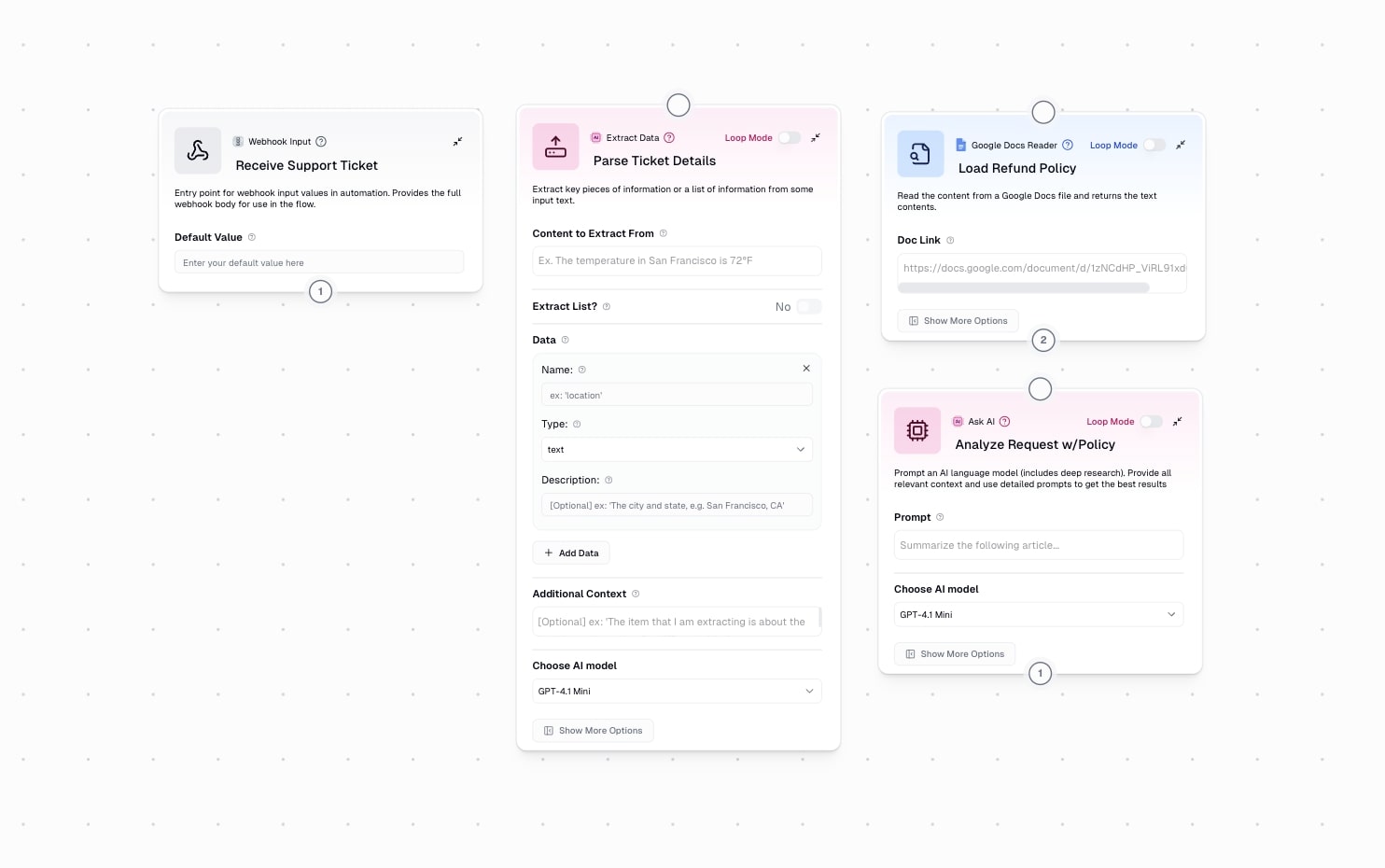
- Category: Support
- How it helps you: Analyzes support requests against company policies, flags exceptions that need manager approval, and scans for 100% policy compliance with a clear audit trail.
Support teams deal with nuances and edge cases all the time. A customer wants a refund outside the standard window. Someone's asking for an exception to your terms of service. Sometimes there’s a script for these less common tickets.
But every now and then, you get something totally new. And they end up sitting in the queue while your team figures out what to do. I’ve seen this first hand multiple times when working in-house.
This is where a support escalation agent becomes valuable.
For example, a customer submits a ticket, "I need a refund for last month, but I'm past the 30 day window because your product had bugs." The agent:
- Analyzes the request against your company policy documents (refund policy, terms of service, SLAs)
- Flags it as an exception and posts to #support-escalations with full context
- Includes why it's flagged: "Refund request exceeds standard 30-day window"
- Provides relevant policy excerpts with highlights
- Adds action buttons: "✅ Approve Exception" / "❌ Deny & Send Template" / "👤 Reassign to Specialist"
If it needs manager approval, the agent tags the right person and tracks the escalation timer. Once approved, the AI drafts a response, gets final confirmation, sends it to the customer, and logs everything in your ticketing system.
Exceptions get handled in under an hour, your team members stay compliant, you have a clear audit trail, and customers get faster resolutions.
8. Customer health alert agent
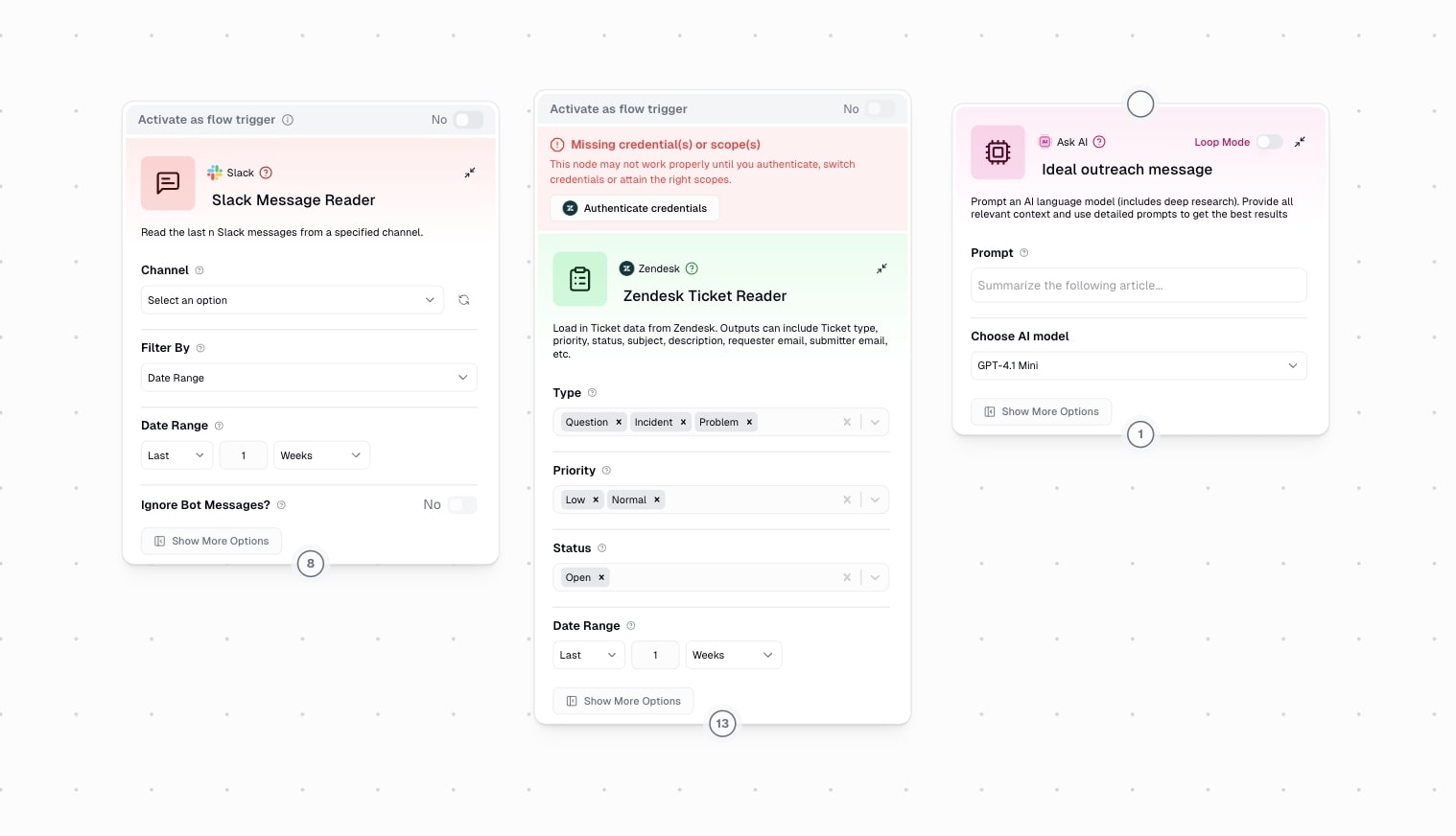
- Category: Support
- How it helps you: Monitors product usage, support tickets, and engagement signals to flag at-risk customers before they churn.
In 2019, I took an in-person course created by Brian Balfour called the Reforge Growth Series. It was taught by early employees at companies like HubSpot, Facebook, Uber, Pinterest, and a bunch of other big brands.
I had two main takeaways from the program.
The first one was that retention breeds acquisition, not the other way around. And that retention was the silent killer of most startups.
In other words, it’s not about getting more customers. The best companies know how important it is to keep their current customers and nurture them so they become advocates of your brand.
Low churn is the goal.
And one of the hardest parts of customer success is knowing when a customer is about to churn before it's too late. By the time they tell you they're canceling, the decision is already made.
This is where a customer health alert agent helps you stay ahead of it.
The agent continuously monitors product usage, NPS scores, and support ticket activity across your customer base. When it detects warning signs, it takes action.
For example, let's say an enterprise customer like Acme Corp hasn't logged in for 10 days and has submitted three bug reports in the last week. The agent:
- Posts an alert to #customer-success: "⚠️ Acme Corp showing churn risk signals"
- Provides full context (last login, recent tickets, sentiment trends)
- Suggests an outreach template based on the issue
- Automatically creates a task in Gainsight or your CS platform
You can also chat with the agent directly in the channel. Ask it "What's the full history on Acme Corp?" or "Show me all accounts that haven't logged in this month" and it pulls the data in seconds.
The result is proactive outreach instead of reactive damage control. You catch issues earlier and reach out before customers go bye bye,
This Slack AI agent is definitely one of my favorites along with the first one I went over. But now, let’s get into the most general of all use cases.
9. Instant knowledge base agent
- Category: Support
- How it helps you: Searches across all your internal docs and past tickets to give support agents instant answers without digging through multiple tools.
When I first started in marketing, I remember being thrown into customer support for a few weeks to "learn the product." The problem was that I had no idea where to find answers to customer questions besides constantly annoying coworkers on Slack.
Someone would ask a technical question, and I'd have to search through Notion, then our public company forum, then old Help Scout tickets, hoping someone had answered this before. By the time I found it, the customer had been waiting way too long.
This is a problem every support team deals with.Especially when they want to run an experiment and get others in the company to help answer support tickets so they can understand common questions and problems people have (great marketing team exercise). But it gets intense as your knowledge base grows across different tools.
This is where an instant knowledge base AI agent comes to play
For example, a team member handling a chat with a custom can go to Slack and type in #support: “/ask How do I reset SSO configuration?” The agent:
- Searches across Notion docs, Confluence (or any support platform you have), and past tickets
- Returns a step-by-step answer with screenshots if available
- Lets the agent copy and paste the response directly to the customer
You can also ask follow-up questions in the channel. "What if the customer is on the legacy plan?" or "Where's the doc on enterprise SSO?" and the agent pulls it immediately.
This not only gives your team faster response times, but it also creates a shorter onboarding for new support team members. When your team has instant access to answers, they handle tickets faster and customers get help without the wait. Then, you can take this a step further and get your AI agent to respond on your behalf.
Okay, by now you’re probably like “Omid, I see the value of these AI Slack agents. But how do I do this for myself?”
Well, I’m glad you asked (or maybe you didn’t and that would be awkward).
But regardless, I feel I owe you a quick guide on how to set up these custom agents for yourself. Don’t worry, it’s a lot easier than you think and you don’t need to be that technical.
How to build a Slack AI agent (in 5 steps)
Building a Slack AI agent might sound complicated, but it's actually pretty straightforward once you break it down step by step. I'm going to walk you through the process using Gumloop, which is what I use to build these agents without writing any code.
The cool thing about building in Gumloop is that you can start simple and add complexity as you go. You don't need to build the perfect agent on day one. Start with something basic, test it, and then layer on more features. That's the beauty of using a AI workflow automation tool.
If you want to watch a full livestream of Aron from Gumloop made on this, you can check it out here:
Otherwise, I’ll give you a rundown below.
Here's how to build a Slack AI agent in 5 steps:
- Start with a simple message and response
- Add context with your documents
- Add routing to decide when to respond
- Pull data from other tools (advanced)
- Test and iterate
Okay, let's go over each step.
1. Start with a simple message and response
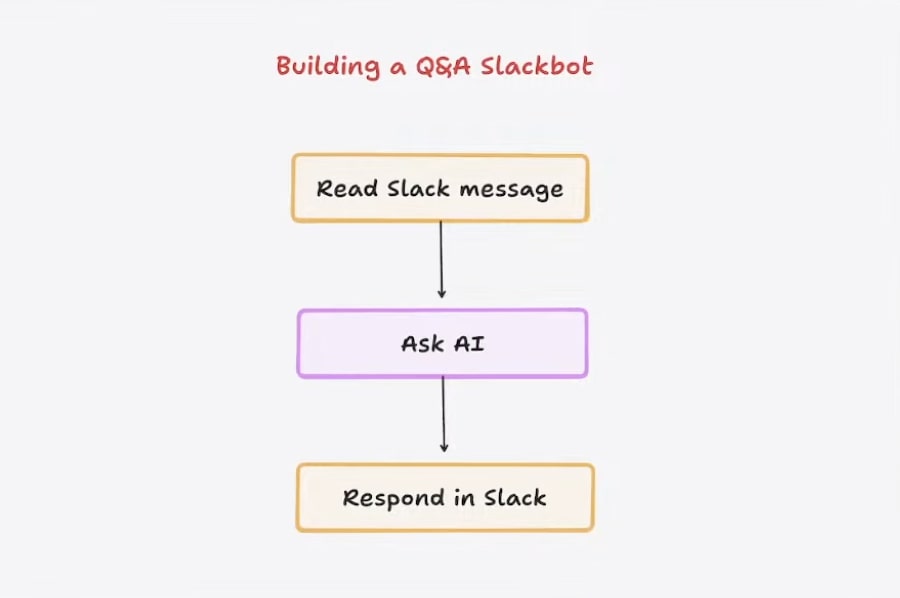
The first version of your Slack AI agent should be dead simple. Just read a message from Slack and have AI respond to it.
Here's how you set it up:
Step 1: Read the message Add a Slack message reader node to your flow. This will pull in messages from whatever Slack channel you choose. Make sure to activate it as a trigger so it runs automatically every time a new message comes in.
Step 2: Send it to AI Add an "Ask AI" node and pass in the message you just read. You can use any large language model you want (GPT, Claude from Anthropic, Gemini — they're all included in Gumloop). Give it a simple prompt like "Respond to this user's question" and pass in the message.
Step 3: Reply in Slack Add a Slack message sender node to send the AI's response back to the channel. Pro tip: make sure to reply in thread so you don't clutter up the channel.
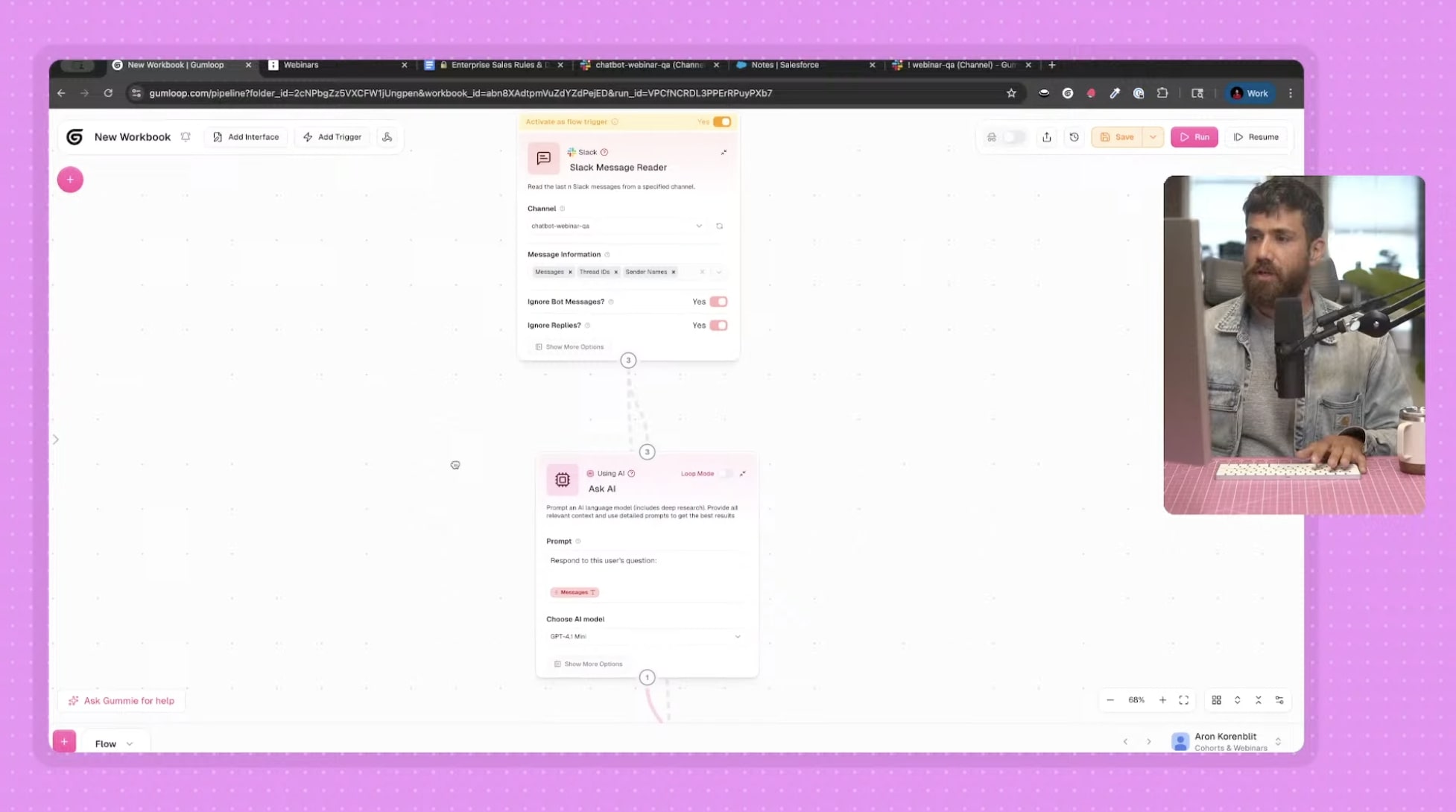
That's it. You now have a basic Slack AI agent that can answer questions. Test it with a simple question and make sure it works before moving on.
2. Add context with your documents
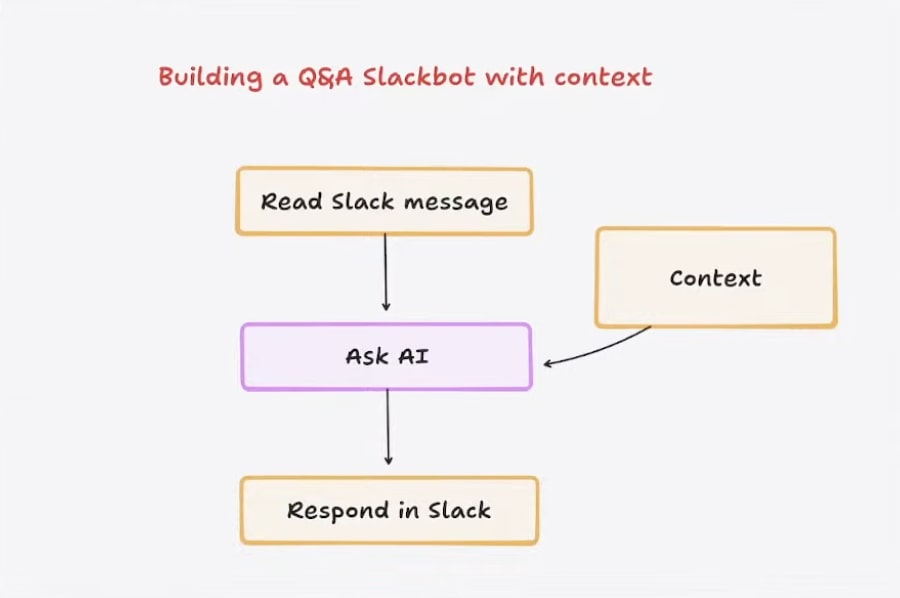
Now that you have the basic flow working, you want to make it actually useful by giving it context. This is where you connect your sales policies, HR docs, knowledge base articles, or whatever documentation you want the agent to reference.
Here's how to add context:
Step 1: Connect your document Add a document reader node (Google Docs, Notion, Confluence - whatever you use). This pulls in the full content of your document.
Step 2: Pass it to AI as context Update your AI prompt to say something like "Use the provided sales policy below to answer the user's question." Then pass in both the user's question and the document content.
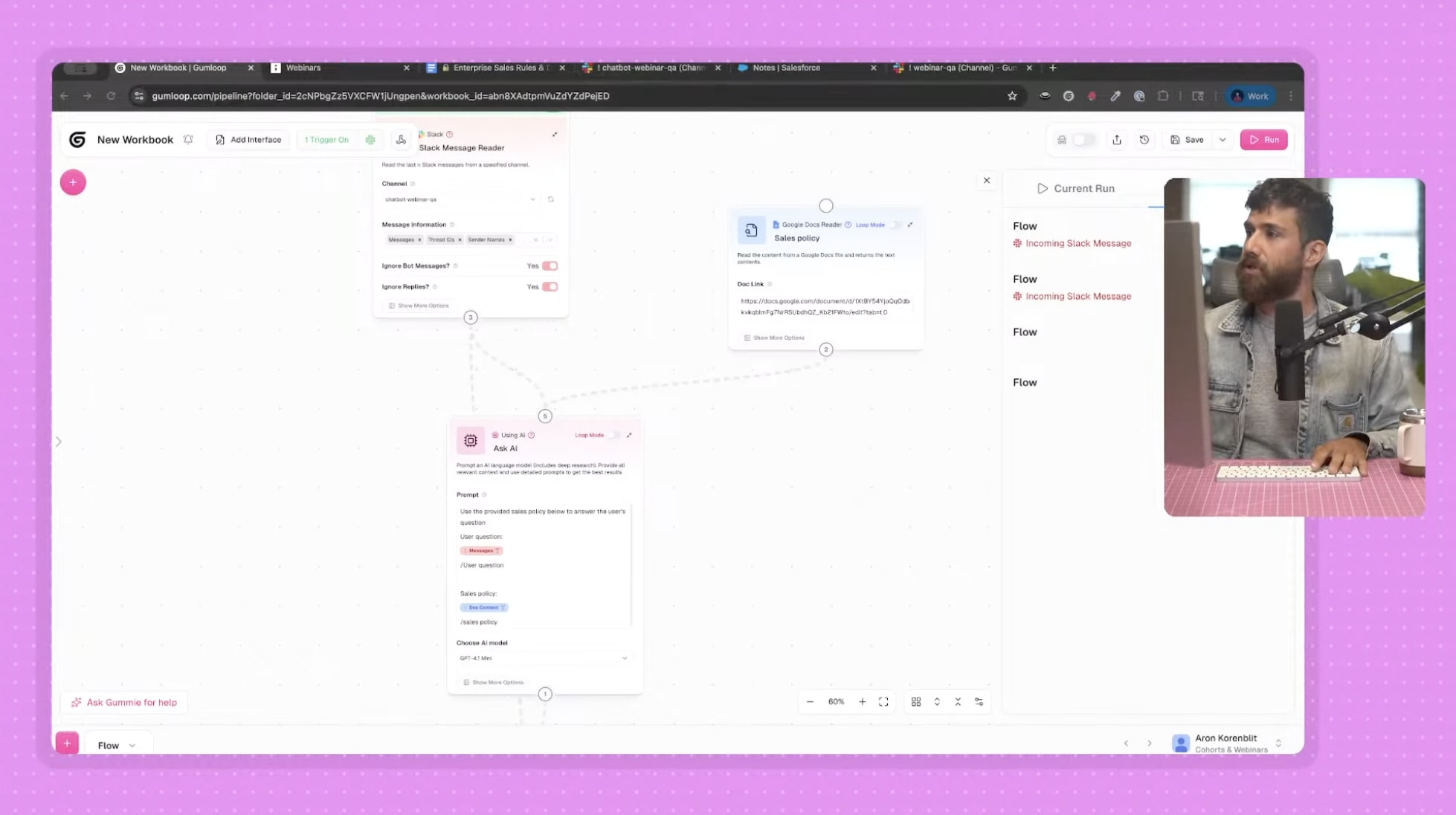
Now your agent can answer questions based on your actual company policies instead of just making stuff up. And the best part is that when someone updates the document, the agent automatically uses the latest version. This is especially helpful for new hires who need quick access to company information without bothering their teammates.
3. Add routing to decide when to respond
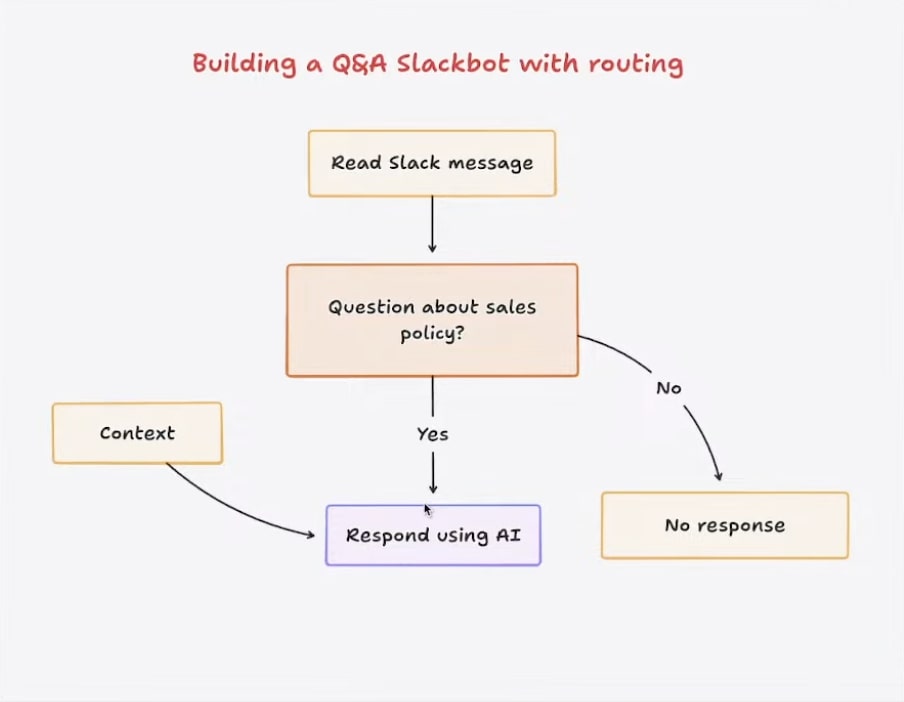
At this point, your agent responds to every single message in the channel. Someone says "good morning" and the agent is like "How can I assist you with sales policy today?" which is annoying.
This is where you add a router node to make decisions about when to respond.
Step 1: Add a router A router node creates different paths based on conditions you set. Think of it like a decision tree.
Step 2: Create your routes Set up your first route for "sales policy questions" and describe what qualifies (questions about discounting, term limits, etc.). Create a second route called "other" for messages that aren't about sales policy.
Step 3: Connect your flows If the message is about sales policy, send it through your existing flow to get a response. If it's "other," just do nothing or log it for review.
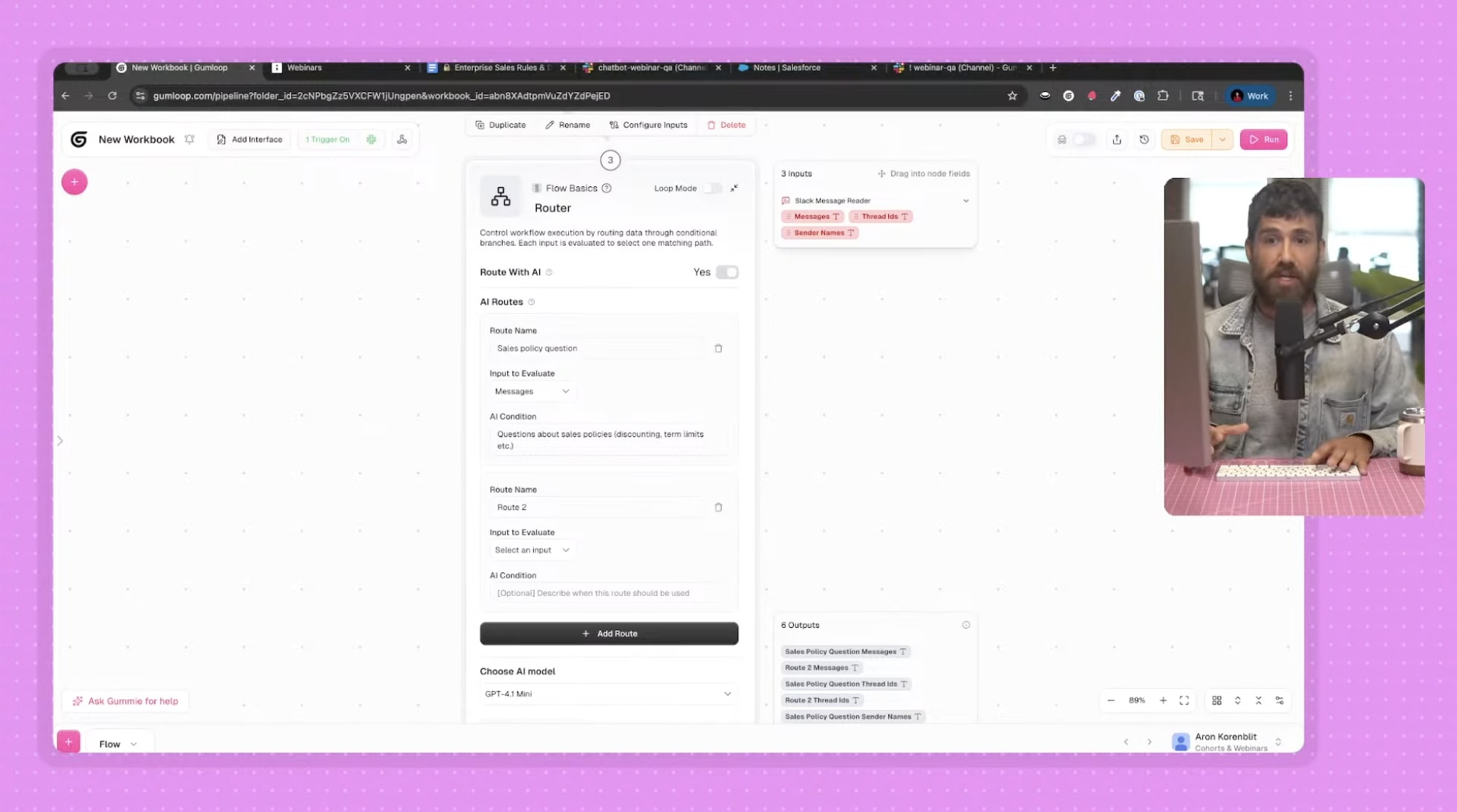
The router uses AI to assess which route to take, so you don't need to write complex logic. You just describe what you want in plain language.
Always go from most specific to least specific when setting up routes. The router checks them one by one and picks the first match.
4. Pull data from other tools (advanced)
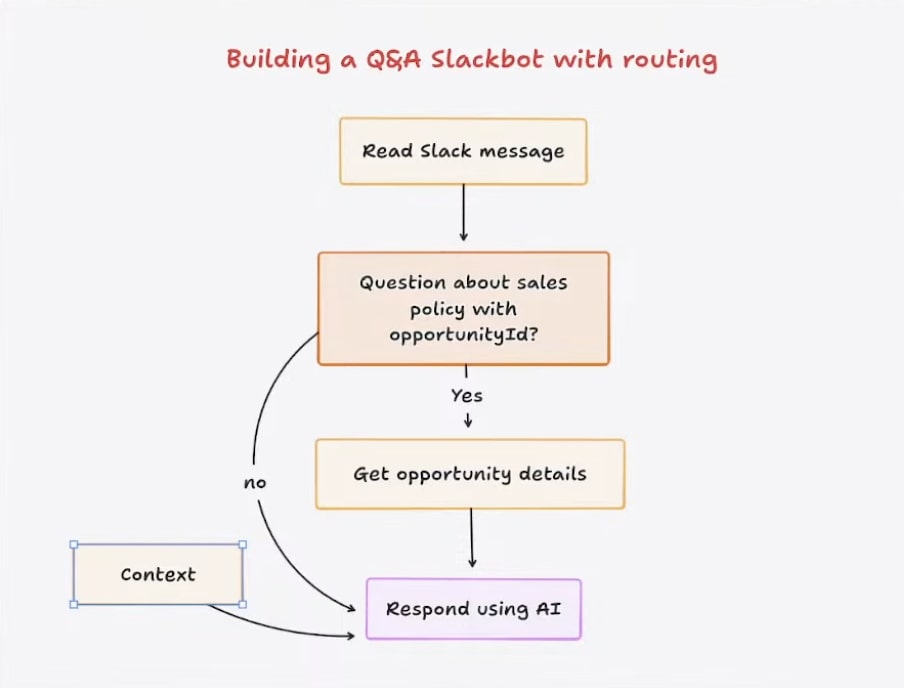
Once you have the basics down, you can get fancy by pulling data from Salesforce, your CRM, project management tools, or anywhere else your team works. This is where APIs come into play and where you can really optimize your workflow.
For example, let's say a sales rep wants to know if they can offer a specific discount to a customer. Instead of just checking the policy, you can have the agent:
- Extract the Salesforce opportunity ID from their message
- Pull all the details and notes from that Salesforce record using APIs
- Read your sales policy
- Combine all that context and give them a specific answer
This is where Slack AI agents become really powerful. You're not just answering generic questions anymore. You're giving personalized, context-aware responses based on real data. The AI features built into these agents can generate summaries of deals, automate routine tasks, and boost productivity by handling work that would normally take 20 minutes in under a minute.
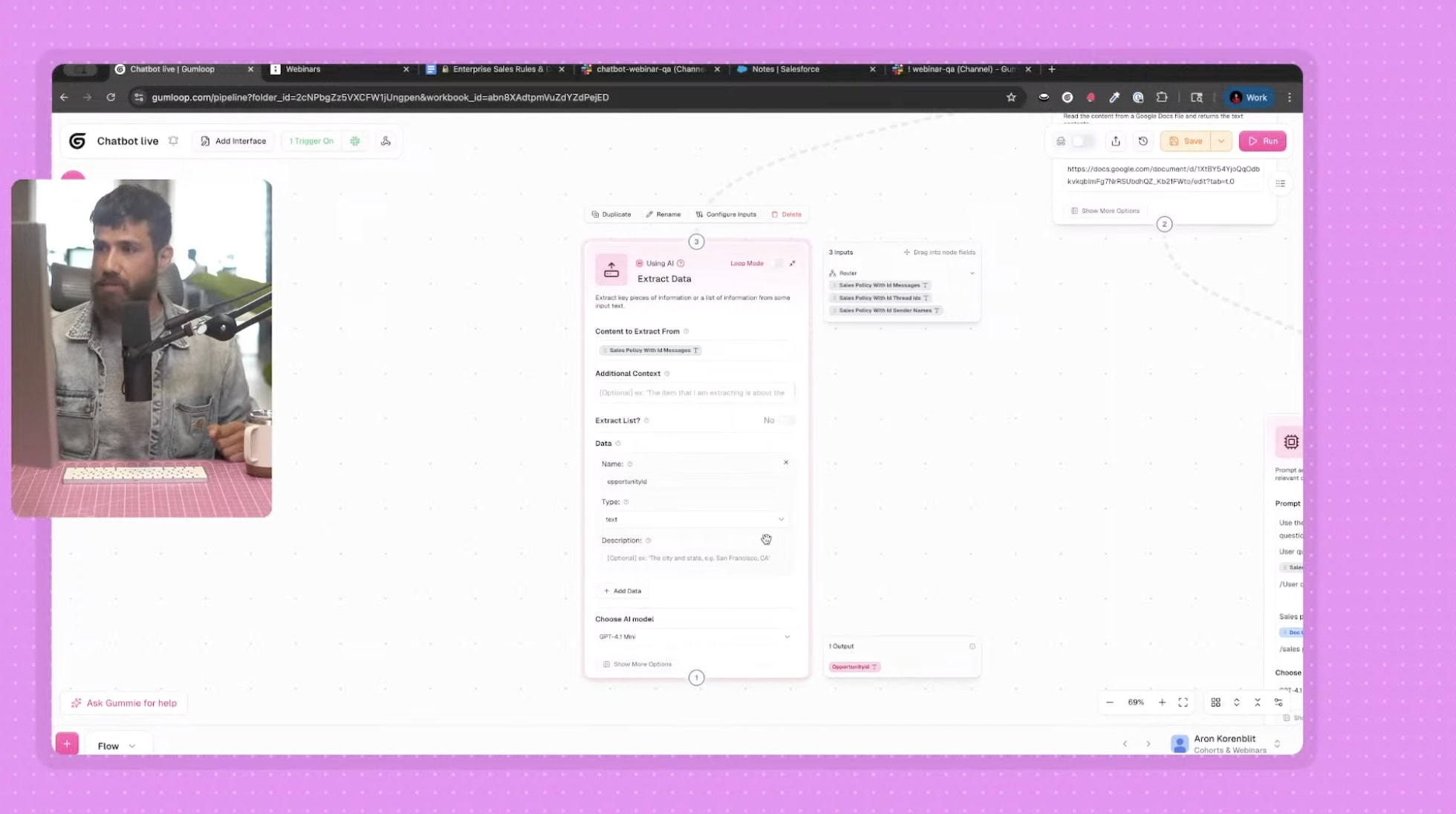
To build this, you add an "extract data" node that pulls the opportunity ID from the message, then connect to Salesforce using an integration node, then pass all that context into your AI prompt. The agent lives right in your flow of work, so your team never has to leave Slack to get what they need.
And note that at any time, you can ask Gummie (the AI assistant in the your Gumloop workflow canvas) to help you build out the agent for you.
5. Test and iterate
The most important thing is to start small and keep testing. Don't try to build the perfect agent on day one. Build version one, see what breaks, and fix it. Then add more features.
Every time you make changes in Gumloop, you can test them without affecting your live agent. Once you're happy with the changes, you publish a new version and it goes live.
And because everything runs through Slack, you can always see what questions people are asking and where the agent is struggling. Use that to improve your prompts, add more context, or build new routes.
That’s it!
I hope by now you realize not only the value for Slack AI agents to streamline communication between your tech stacks, but also you feel confident going out and building them yourself. Can’t wait to see what you build!
Read related articles
Check out more articles on the Gumloop blog.
Create automations
you're proud of
Start automating for free in 30 seconds — then scale your
superhuman capabilities without limits.


















